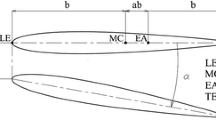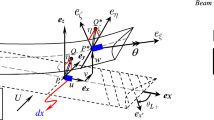Abstract
The aeroelastic analysis of a cropped delta wing in compressible flow is presented in this work. Tests using isotropic and orthotropic materials, as well as laminated composite materials, are performed, keeping the same geometry for each case and investigating the wing behavior using different dynamic pressures. A computational framework based in a staggered procedure with separated finite element codes for fluid and structural domains is used. Geometrically nonlinear effects are incorporated into the structural analysis employing a corotational formulation, while simple and efficient algorithms are adopted to deal with mesh motion and information transfer between fluid and structure, using non-matching meshes at the interface. The proposed framework is tested using the isotropic wing and comparing results obtained here with those obtained from other works. The limit-cycle oscillation, characterizing the isotropic wing behavior, is also obtained in simulations carried out on an orthotropic wing with a single layer, but larger displacements are observed. Finally, the aeroelastic analysis of a laminated composite wing is performed and a significantly different behavior with respect to previous cases is observed, taking into account that for some flow conditions the structural motion is damped, and for other flow conditions structural motion is amplified to levels where the fluid mesh became highly distorted.

























Similar content being viewed by others
Notes
Pressure is given in psi (1 psi = 6895 Pa) in order to easy comparison with other authors.
References
Almeida FS, Awruch AM (2011) Corotational nonlinear dynamic analysis of laminated composite shells. Finite Elem Anal Des 47(10):1131–1145
Argyris J, Doltsinis IS, Friz H (1990) Studies on computational reentry aerodynamics. Comput Methods Appl Mech Eng 81(3):257–289
Attar PJ, Gordnier RE (2006) Aeroelastic prediction of the limit cycle oscillations of a cropped delta wing. J Fluids Struct 22(1):45–58
Clark R, Cox D, Curtiss HCJ, Edwards JW, Hall KC, Peters DA, Scanlan R, Simiu E, Sisto F, Strganac TW et al (2004) A modern course in aeroelasticity. Solid mechanics and its applications. Springer
Crisfield MA (1997) Non-linear finite element analysis of solid and structures. Vol 2: advanced topics. Wiley
Crisfield MA, Shi J (1994) Co-rotational element/time-integration strategy for non-linear dynamics. Int J Numer Methods Eng 37(11):1897–1913
Crisfield MA, Galvanetto U, Jelenic G (1997) Dynamics of 3-d co-rotational beams. Comput Mech 20(6):507–519
Farhat C, Lesoinne M (2000) Two efficient staggered algorithms for the serial and parallel solution of three-dimensional nonlinear transient aeroelastic problems. Comput Methods Appl Mech Eng 182(3–4):499–515
Farhat C, Lesoinne M, Tallec PL (1998) Load and motion transfer algorithms for fluid/structure interaction problems with non-matching discrete interfaces: Momentum and energy conservation, optimal discretization and application to aeroelasticity. Comput Methods Appl Mech Eng 157(1–2):95–114
Felippa CA (2003) A study of optimal membrane triangles with drilling freedoms. Comput Methods Appl Mech Eng 192(16–18):2125–2168
Felippa CA, Haugen B (2005) A unified formulation of small-strain corotational finite elements: I. theory. Comput Methods Appl Mech Eng 194(21–24):2285–2335
Gordnier R, Melville R (2001) Numerical simulation of limit-cycle oscillations of a cropped delta wing using the full Navier–Stokes equations. Int J Comput Fluid Dyn 14:211–224
Gordnier RE (2003) Computation of limit-cycle oscillations of a delta wing. J Aircr 40(6):1206–1208
Hughes TJR, Liu WK, Zimmermann TK (1981) Lagrangian-eulerian finite element formulation for incompressible viscous flows. Comput Methods Appl Mech Eng 29(3):329–349
Lesoinne M, Farhat C (1998) Higher-order subiteration-free staggered algorithm for nonlinear transient aeroelastic problems. AIAA J 36:1754–1757
Löhner PR (2001) Applied computational fluid dynamics techniques: an introduction based on finite element methods. Wiley
Nithiarasu P, Zienkiewicz OC, Sai BVK, Morgan K, Codina R, Vázquez M (1998) Shock capturing viscosities for the general fluid mechanics algorithm. Int J Numer Methods Fluids 28(9):1325–1353
Nour-Omid B, Rankin CC (1991) Finite rotation analysis and consistent linearization using projectors. Comput Methods Appl Mech Eng 93(3):353–384
Peng C, Han J (2011) Numerical investigation of the effects of structural geometric and material nonlinearities on limit-cycle oscillation of a cropped delta wing. J Fluids Struct 27(4):611–622
Piperno S, Farhat C (2001) Partitioned procedures for the transient solution of coupled aeroelastic problems - part ii: energy transfer analysis and three-dimensional applications. Comput Methods Appl Mech Eng 190(24–25):3147–3170
Rankin CC, Brogan FA (1986) An element independent corotational procedure for the treatment of large rotations. J Press Vessel Technol 108(2):165–174
Relvas A, Suleman A (2006) Fluid-structure interaction modelling of nonlinear aeroelastic structures using the finite element corotational theory. J Fluids Struct 22(1):59–75
Schairer ET, Hand LA (1999) Measurements of unsteady aeroelastic model deformation by stereo photogrammetry. J Aircr 36(6):1033–1040
Teixeira PRF, Awruch AM (2005) Numerical simulation of fluidstructure interaction using the finite element method. Comput Fluids 34(2):249–273
Zhang YX, Kim KS (2005) A simple displacement-based 3-node triangular element for linear and geometrically nonlinear analysis of laminated composite plates. Comput Methods Appl Mech Eng 194(45–47):4607–4632
Zienkiewicz OC, Taylor RL, Nithiarasu P (2005) The finite element method for fluid dynamics. The finite element method. Elsevier Butterworth-Heinemann
Acknowledgments
The authors wish to thank the Brazilian agencies CNPq and CAPES for their financial support. Authors are also very thankful to National Center for Super-Computing at Federal University of Rio Grande do Sul CESUP/UFRGS for providing the computational infrastructure.
Author information
Authors and Affiliations
Corresponding author
Additional information
Technical Editor: Kátia Lucchesi Cavalca Dedini.
Rights and permissions
About this article
Cite this article
de Almeida, F.S., Awruch, A.M. Aeroelastic analysis of wings with isotropic and orthotropic materials in compressible flow. J Braz. Soc. Mech. Sci. Eng. 38, 1087–1102 (2016). https://doi.org/10.1007/s40430-015-0414-5
Received:
Accepted:
Published:
Issue Date:
DOI: https://doi.org/10.1007/s40430-015-0414-5




